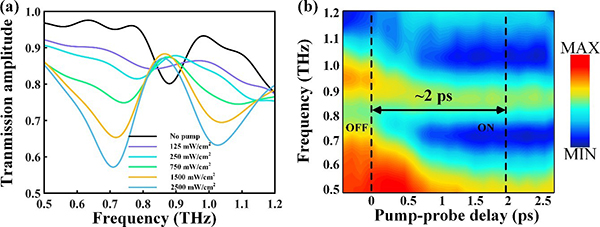Terahertz (THz) waves are electromagnetic waves between microwaves and infrared light, possessing a frequency range from 0.1 THz to 10 THz. Particularly, THz waves share the characteristics of both microwave and light waves, and exhibit distinguished physical properties, such as low quantum energy, strong penetrability and large bandwidth, granting themselves great potentials for applications in wireless transmission of large-capacity data. Furthermore, the THz spectrum band is the key to the development of 6G mobile communication networks that require the wireless data transmitting speed to exceed TB per second. Fortunately, the THz spectrum band provides a higher usable bandwidth, and hence meets the ever-increasing demand for higher data transmission rates. Due to the high absorption rate of the water vapor to THz waves, the propagation of THz waves in the atmosphere attenuates drastically with distance, which is conducive to the achievement of secure communication in space. On the other hand, the THz technology also has broad application prospects infields of biomedicine, environmental science, material science, public security, and national defense and military. Therefore, the researching of THz components with a large modulation range and a fast operation speed is of great significance to promote the development of THz technology. At present, due to the lack of widespread practical applications in the range of THe frequency, the THz band is also called "THz gap". It is currently very difficult to obtain active and efficient active-control THz devices, which hinders the advancement and applications of the THz technology.
Metamaterials are artificially designed periodic structures composed of subwavelength resonators, presenting electromagnetic properties that are absence in natural materials, which can achieve flexible control of the incident electromagnetic field in the frequency domain of interest. The analog of Electromagnetically Induced Transparency (EIT) effect in THz metamaterials is a special electromagnetic phenomenon realized by using metamaterials to modulate the free space THz electromagnetic field. The destructive interference between the super-radiation (bright mode) and sub- radiation (dark mode) modes supported by the metamaterials forms a transparent window with a high value of quality factor (Q factor), which endows transmitted electromagnetic waves with high transparency, low loss, and strong dispersion in a certain frequency spectrum. Metamaterials have been widely used in the fields of slow light technology, optical storage, and biosensing. Up to date, the majority of metamaterials cannot be changed or altered after being fabricated. Thus, the dynamic control of optical properties of metamaterials is in great need for applications including free space optical communications and depth sensing.
To solve the above problems, Hao Sun et al. from the National University of Defence Technology demonstrated in Chinese Optics Letters, Volume 18, Issue 9 (H. Sun, et al., Active Formating Modulation of Electromagnetically Induced Transparency in Metamaterials) that by introducing active controllable materials, they realized the active formation process of analog of EIT effects in the THz frequency domain for the first time, which provided a feasible solution for the development of high- performance optically controlled THz functional devices.
In the design of the metamaterials, the cut wire resonator (SCW) and the split ring resonator (SRR) realize the electromagnetic field resonance of the bright mode and the dark mode, respectively, while the interference between two modes realizes the EIT-like effect. By embedding the silicon semiconductor layer in the SCW, the active optical control of the bright mode is realized, and then the active formation process of the EIT-like effect is successfully realized as well. Experimental results show that with the introduction of pump light with a wavelength of 800 nm, the transmission dip at 0.87 THz is suppressed. As the power of the optical pump increases, more photo-generated carriers are excited to turn on the SCW, realizing the bright mode and the interference between the dark mode and the bright mode. An EIT-like transparent window is realized at 0.89 THz, accompanied with a remarkable slow light effect. The dynamic process of this phenomenon is studied by using the optical-
pump THz-probe (OPTP) technology, and the active formation process of which can be completed in the picosecond time scale. In subsequent works, based on the active formatting process of the EIT-like effect, the polarization-dependent modulation of the formation and suppression process of the EIT-like effect can be researched, utilizing the polarization property of the free space electromagnetic field. The active control of the EIT-like effect utilizing metamaterials is not only limited to the THz range, but also perform much meaning reference in optical applications from infrared to microwave, such as multi- band sensing, ultra-wideband wireless communications, and nonlinear optics.
Associate Professor Xin Zheng from the National Innovation Institute of Defense Technology believes that when compared with previous work on EIT-like effects, which mainly focused on the process of suppression, this work successfully realized the active formation process for the first time, which is extremely important and attractive to the development and promotion of wireless optical communications.

(a) Experimentally measured transmission spectrum of metadevice considering a series of selected optical fluences. (b) Color map showing the active formatting process of PIT effect.


